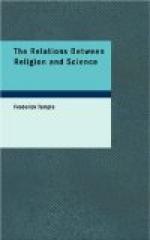To the many partial designs which Paley’s Natural Theology points out, and which still remain what they were, the doctrine of Evolution adds the design of a perpetual progress. Things are so arranged that animals are perpetually better adapted to the life they have to live. The very phrase which we commonly use to sum up Darwin’s teaching, the survival of the fittest, implies a perpetual diminution of pain and increase of enjoyment for all creatures that can feel. If they are fitter for their surroundings, most certainly they will find life easier to live. And, as if to mark still more plainly the beneficence of the whole work, the less developed creatures, as we have every reason to believe, are less sensible of pain and pleasure; so that enjoyment appears to grow with the capacity for enjoyment, and suffering diminishes as sensitivity to suffering increases. And there can be no doubt that this is in many ways the tendency of nature. Beasts of prey are diminishing; life is easier for man and easier for all animals that are under his care: many species of animals perish as man fills and subjugates the globe, but those that remain have far greater happiness in their lives. In fact, all the purposes which Paley traces in the formation of living creatures are not only fulfilled by what the Creator has done, but are better fulfilled from age to age. And though the progress may be exceedingly slow, the nature of the progress cannot be mistaken.
If the Natural Theology were now to be written, the stress of the argument would be put on a different place. Instead of insisting wholly or mainly on the wonderful adaptation of means to ends in the structure of living animals and plants, we should look rather to the original properties impressed on matter from the beginning, and on the beneficent consequences that have flowed from those properties. We should dwell on the peculiar properties that must be inherent in the molecules of the original elements to cause such results to follow from their action and reaction on one another. We should dwell on the part played in the Universe by the properties of oxygen, the great purifier, and one of the great heat-givers; of carbon, the chief light-giver and heat-giver; of water, the great solvent and the storehouse of heat; of the atmosphere and the vapours in it, the protector of the earth which it surrounds. We should trace the beneficent effects of pain and pleasure in their subservience to the purification of life. The marks of a purpose impressed from the first on all creation would be even more visible than ever before.




